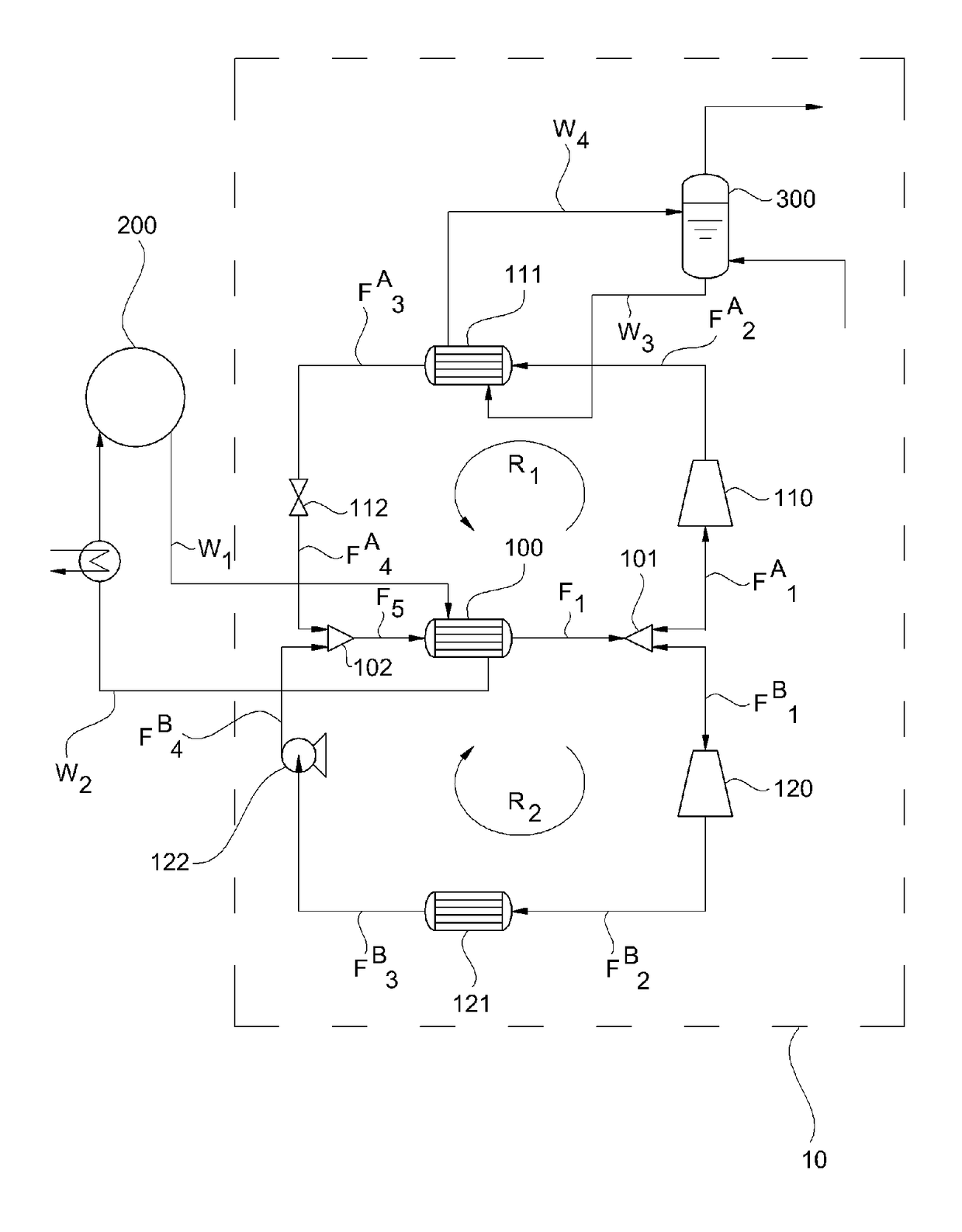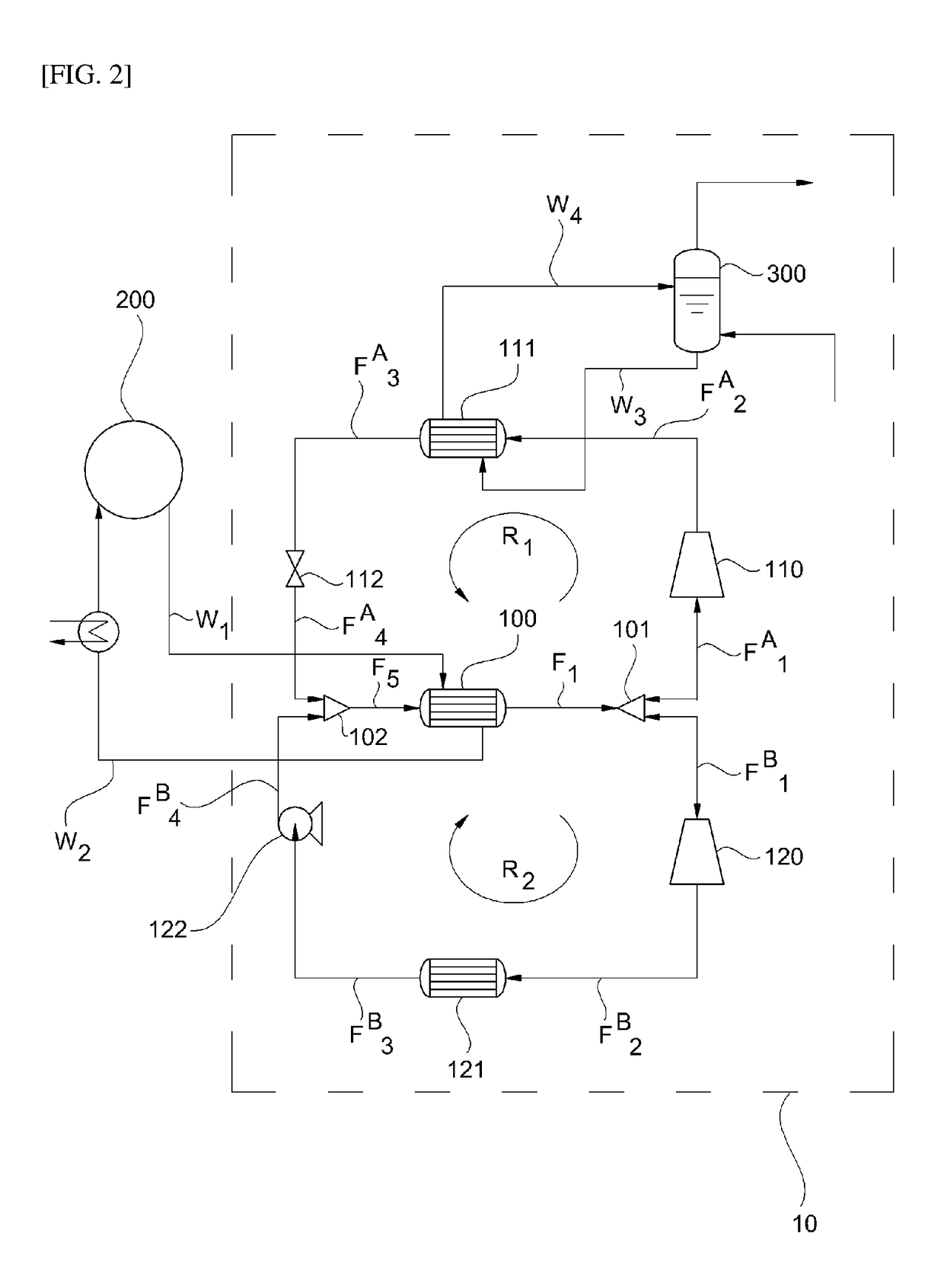Heat recovery apparatus
a heat recovery and heat recovery technology, applied in the field of heat recovery apparatus and method, can solve the problems of large amount of energy consumption, inability to substantially reuse waste heat, and waste heat condensed by condensate water, etc., and achieve the effect of maximizing energy reduction efficiency and excellent heat recovery efficiency
- Summary
- Abstract
- Description
- Claims
- Application Information
AI Technical Summary
Benefits of technology
Problems solved by technology
Method used
Image
Examples
example 1
[0135]Steam was generated using a heat recovery apparatus of FIG. 5.
[0136]A refrigerant 1,1,1,3,3-pentafluoropropane (R245fa) was allowed to flow into an evaporator and to circulate to allow one part of a refrigerant flow separated from the evaporator to sequentially pass through a compressor, a first condenser, and a pressure-dropping device. In detail, a refrigerant flow in a state of 69.6° C., 6.2 kgf / cm2g (7.1 bar), and a gas volume fraction of 0.0 was allowed to flow into the evaporator at a flow rate of 50,000 kg / hr, and simultaneously, a waste heat flow in a state of 85.0° C., 1.0 kgf / cm2g (1.96 bar), and a gas volume fraction of 0.0 was allowed to flow into the evaporator at a flow rate of 300,000 kg / hr to be heat-exchanged. After the heat-exchange, the waste heat flow was discharged in a state of 78.2° C., 1.0 kgf / cm2g (1.96 bar), and a gas volume fraction of 0.0 at a flow rate of 300,000 kg / hr and the refrigerant flow was discharged in a state of 80.0° C., 6.2 kgf / cm2g (7....
example 2
[0140]Steam was generated using a heat recovery apparatus of FIG. 7.
[0141]A refrigerant 1,1,1,3,3-pentafluoropropane (R245fa) was allowed to flow into an evaporator and to circulate to allow one part of a refrigerant flow separated from the evaporator to sequentially pass through a first heat exchanger, a compressor, a first condenser, the first heat exchanger, and a pressure-dropping device. In detail, a refrigerant flow in a state of 69.6° C., 6.2 kgf / cm2g (7.1 bar), and a gas volume fraction of 0.0 was allowed to flow into the evaporator at a flow rate of 50,000 kg / hr, and simultaneously, a waste heat flow in a state of 85.0° C., 1.0 kgf / cm2g (1.96 bar), and a gas volume fraction of 0.0 was allowed to flow into the evaporator at a flow rate of 300,000 kg / hr to be heat-exchanged. After the heat-exchange, the waste heat flow was discharged in a state of 78.2° C., 1.0 kgf / cm2g (1.96 bar), and a gas volume fraction of 0.0 at a flow rate of 300,000 kg / hr and the refrigerant flow was d...
example 3
[0144]A refrigerant flow discharged from an evaporator was allowed to flow into a fluid distributor and separated. After separating the refrigerant flow in the fluid distributor, one part of the refrigerant flow separated in the fluid distributor was allowed to flow into a compressor at a flow rate of 25,000 kg / hr and another part of the refrigerant flow separated in the fluid distributor was allowed to flow into the turbine at a flow rate of 25,000 kg / hr. Also, water which flowed into a first condenser was allowed to flow thereinto at a flow rate of 3,000 kg / hr and the heat-exchanged water was discharged from the first condenser as steam in a state of 115.0° C., 0.7 kgf / cm2g (1.67 bar), and a gas volume fraction of 0.33. Except those described above, the steam was generated through the same method as that of Experimental Example 1.
[0145]A coefficient of performance of the heat recovery apparatus in this case was shown in Table 1.
PUM
 Login to View More
Login to View More Abstract
Description
Claims
Application Information
 Login to View More
Login to View More - R&D
- Intellectual Property
- Life Sciences
- Materials
- Tech Scout
- Unparalleled Data Quality
- Higher Quality Content
- 60% Fewer Hallucinations
Browse by: Latest US Patents, China's latest patents, Technical Efficacy Thesaurus, Application Domain, Technology Topic, Popular Technical Reports.
© 2025 PatSnap. All rights reserved.Legal|Privacy policy|Modern Slavery Act Transparency Statement|Sitemap|About US| Contact US: help@patsnap.com



